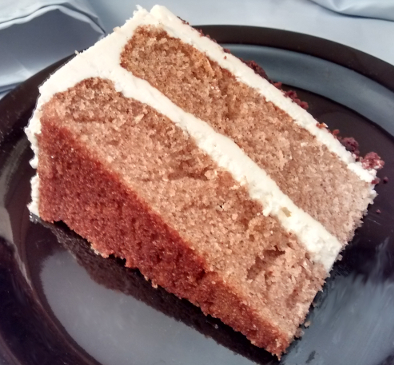Most apple cakes are rustic, dense desserts. I wanted to create a downy, elegant apple cake, suitable for serving in a more formal setting. So I took the flavor of an apple cider doughnut and the structure of a red velvet cake and produced a soft, sophisticated cake, perfect for autumn.

- 2.5 cups (280 grams) cake flour, sifted
- 2 Tablespoons cornstarch
- 1 Tablespoon Ceylon cinnamon
- .25 teaspoon freshly-grated nutmeg (use a Microplane)
- 1.5 cups canola oil
- 2 large eggs, at room temperature
- 1 cup apple cider, at room temperature
- .25 cup buttermilk, at room temperature
- 1 teaspoon vanilla
- 2 teaspoons kosher salt (or 1 teaspoon table salt)
- 1.5 cups (288 grams) minimally-processed sugar (I use Florida Crystals.)
- 1.5 teaspoons baking soda
- 1 Tablespoon apple cider vinegar
Heat your oven to 350 degrees Fahrenheit. Grease or spray two 9”x3” round baking pans. Set them aside.
In the bowl of a stand mixer fitted with the paddle attachment, combine the cake flour, cornstarch, Ceylon cinnamon and grated nutmeg. Turn the mixer on at its lowest setting and allow these ingredients to mix for three minutes.
Add the canola oil to the mixing bowl and using the lowest setting continue to mix until all of the dry ingredients are coated with the oil. Add the eggs, one at a time, combining after each addition. Stop the mixer, scrape the sides and bottom of the bowl and continue to mix until throughly combined.
In another bowl, combine the apple cider, buttermilk, vanilla and salt. Stir until the salt is dissolved. In thirds, add the cider mix and sugar to the mixer’s bowl, combining after each addition. Scrape the bottom and sides of the bowl and stir again until throughly combined. Turn the mixer to medium speed and beat the batter for three minutes.
In a very small bowl, combine the baking soda and apple cider vinegar until it bubbles. You must now work quickly so the leavening ability of the baking soda does not expire. Dump the vinegar/soda mixture into the mixer’s bowl, scraping the small bowl to be sure to get all of it. Stir for ten seconds. Divide the batter between the baking pans and rap them on a flat surface to settle the batter.
Bake the layers for 25 to 29 minutes, until a toothpick inserted in the center comes out clean.
Remove from the oven and cool on a rack for 10 minutes. Remove the layers from the pans and cool to room temperature on the rack.
Buttercream Frosting
- whites from 5 large eggs, at room temperature
- .25 teaspoon cream of tartar
- 1.25 cups minimally-processed sugar, divided
- pinch of salt
- .5 cup apple cider
- 1 pound (4 sticks) unsalted butter, softened at room temperature
- 1 teaspoon apple cider vinegar
Fit your stand mixer with the whisk attachment. Add the egg whites to the bowl and whip on high speed until bubbly. Add the cream of tartar and continue whipping until soft peaks form. Add .25 cup of the minimally-processed sugar to the bowl and continue whipping until firm peaks form. Turn the mixer off.
In a sturdy saucepan combine the salt, apple cider and remaining cup of minimally-processed sugar. Place it over high heat and monitor with a candy thermometer. Cook until the mixture reaches 244 degrees Fahrenheit.
Turn the mixer to high and slowly add the sugar syrup to the whipped egg whites. (If you cannot do this with the mixer on, turn the mixer off to add a small amount of syrup, then turn the mixer on to incorporate. Repeat until all of the syrup is in the eggs.)
Continue whipping the eggs and sugar until the outside of the bowl has cooled down. With the mixer still on, add the butter, one tablespoon at a time. Be sure each tablespoon of butter is fully incorporated before you introduce the next. When all of the butter is incorporated, you may find that your frosting is too “soupy”. This usually means that the eggs were too warm when you began adding butter. Just continue to beat it; it should firm up. Finally, add the teaspoon of apple cider vinegar and beat until incorporated.